“I have a British background and I have always had tea and something sweet. First time I tried this clotted cream I almost ate the entire jar by itself, it is that good!” ~Kim

If you’ve never had a classic English afternoon tea with scones and clotted cream, you’re missing out!
Last week I was treated by the historic Biltmore Hotel in downtown Los Angeles to their classic English afternoon tea. If you’ve never had a classic afternoon tea, you need to experience it. The highlight of any afternoon tea, besides the tea, is the array of tiny treats that comes with it, and I always zero right in on the scones and clotted cream. (That’s them on level two of our 3 tiered tea tray.)

What is Clotted cream?
If you’ve never had it, clotted cream is a very thick rich spreadable form of heavy cream that was first invented ages ago by some very smart British farmers. Traditionally cream heated until it thickens and develops a slightly nutty flavor. Clotted cream has a high fat content (around 55-65%) and a dense texture. It’s not like whipped cream, or cream cheese, it’s not like butter…it has a unique decadent consistency and a wonderful soft flavor. It’s quite thick and spreadable, and when you slather it on a freshly baked scone there is no better thing in the world.
The little pot of clotted cream that we got at the Biltmore had me craving more, and happily I made the most astounding discovery…you can actually make clotted cream at home in your own kitchen. No more tracking it down in specialty stores and paying big bucks for the imported stuff. My homemade clotted cream was actually way better (and a whole lot fresher) than the British stuff I usually buy.

What does clotted cream taste like?
Clotted cream has a rich, creamy taste with a slightly nutty ‘cooked’ flavor. It’s luxurious and indulgent, with a dense, velvety texture that is thicker and creamier than regular whipped cream. Clotted cream is also slightly sweet, but not as sweet as whipped cream or frosting, with a delicate flavor that pairs well with desserts, fruit, and scones. The crust on top of the clotted cream adds a slightly caramelized and nutty flavor, which many people find particularly delicious. The mouthfeel of clotted cream is a key part of its charm, and is like nothing else you’ve ever had!
what you’ll need
- heavy or whipping cream that has not been ultra-pasteurized
- This is cream that has been pasteurized, but not ultra-pasteurized. Ultra-pasteurized cream is cream that has been heated to a higher temperature than regular pasteurized cream to extend its shelf life.

How to make clotted cream
This is an amazing process, I hardly had to do anything, and I end up with a ton of the richest, silkiest clotted cream I’ve ever had.
- I used 2 pints of (non-ultra-pasteurized) heavy cream.
- I poured them into a baking dish, and left it overnight in a 180F oven (the lowest my oven will go.)
- In the morning I let it cool and then refrigerated it for the rest of the day.
- Then I scooped it into jars, which was a little sloppy at first, and put them back in the refrigerator. Any little bit of liquid gets absorbed right into the clotted cream after you put it in the jars, and by the next morning when I had it with my scones, it was absolutely to die for.
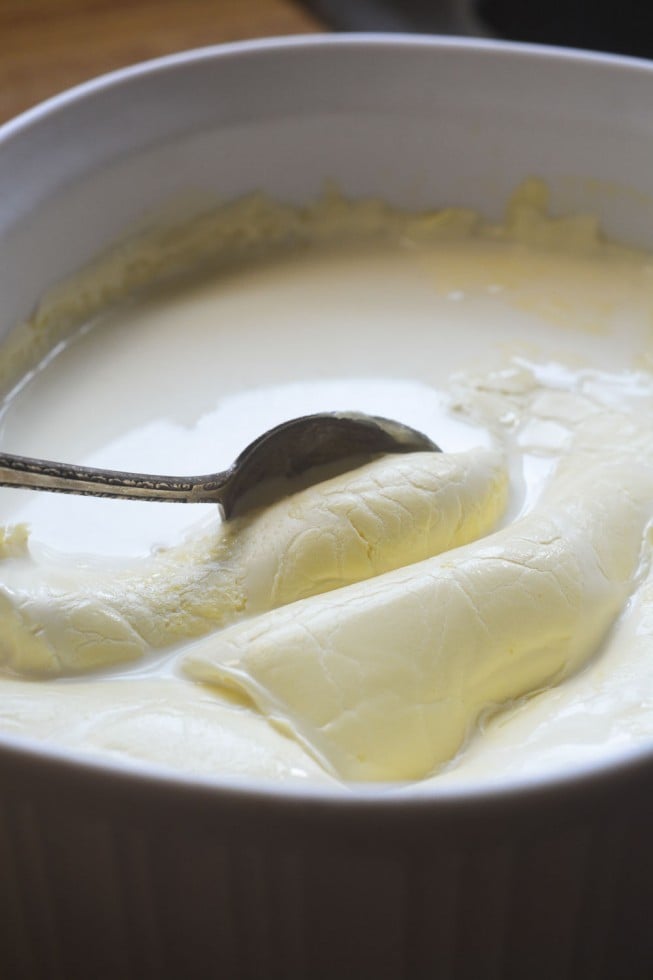
How long does clotted cream last?
Homemade clotted cream can last for up to 3-4 days when stored properly in the refrigerator. To extend its shelf life, it’s important to keep it in an airtight container and store it in the coldest part of the refrigerator, such as the back of the bottom shelf.
It’s important to note that clotted cream does not have any preservatives, so it should be consumed as soon as possible for the best flavor and texture. If you notice any changes in color, texture, or odor, discard the clotted cream immediately as it may have spoiled.
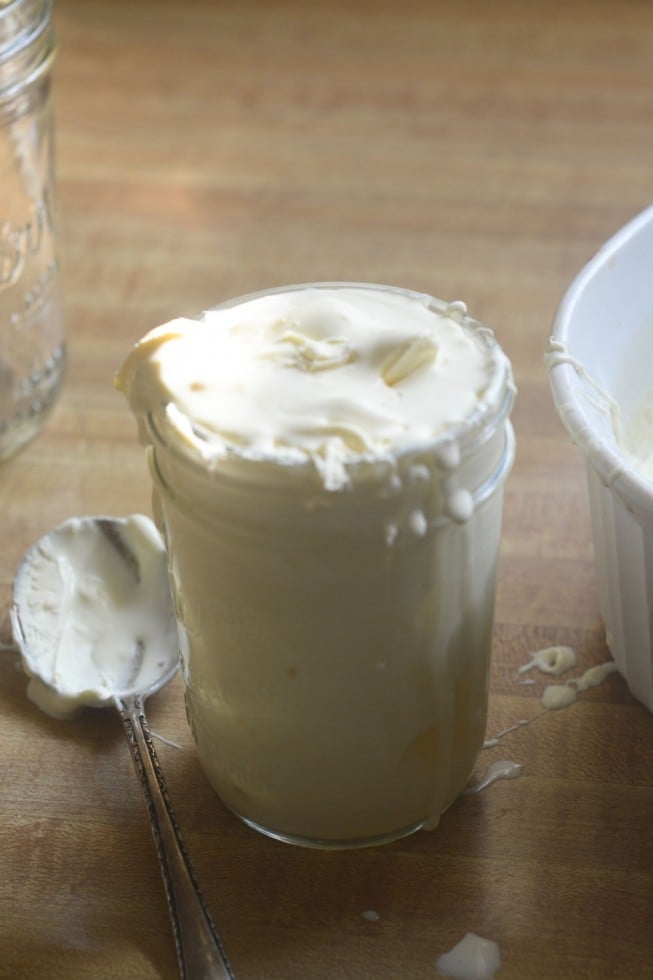
What to do with the leftover whey from making clotted cream
The leftover whey from making clotted cream can be used in a variety of ways:
- Adding it to smoothies or protein shakes for a boost of protein and nutrients.
- Using it as a substitute for milk or water in baking recipes such as bread, muffins, and pancakes.
- Using it as a marinade for meat or fish to tenderize and add flavor.
- Adding it to soups or stews for added richness and flavor.
- Using it as a liquid base for making homemade ricotta cheese or other soft cheeses.
- Feeding it to pets, as it is a good source of protein and nutrients for animals.
Note: It’s important to keep in mind that the leftover whey should be used or stored promptly to avoid spoilage. It can be stored in the refrigerator for up to a week or frozen for longer storage.
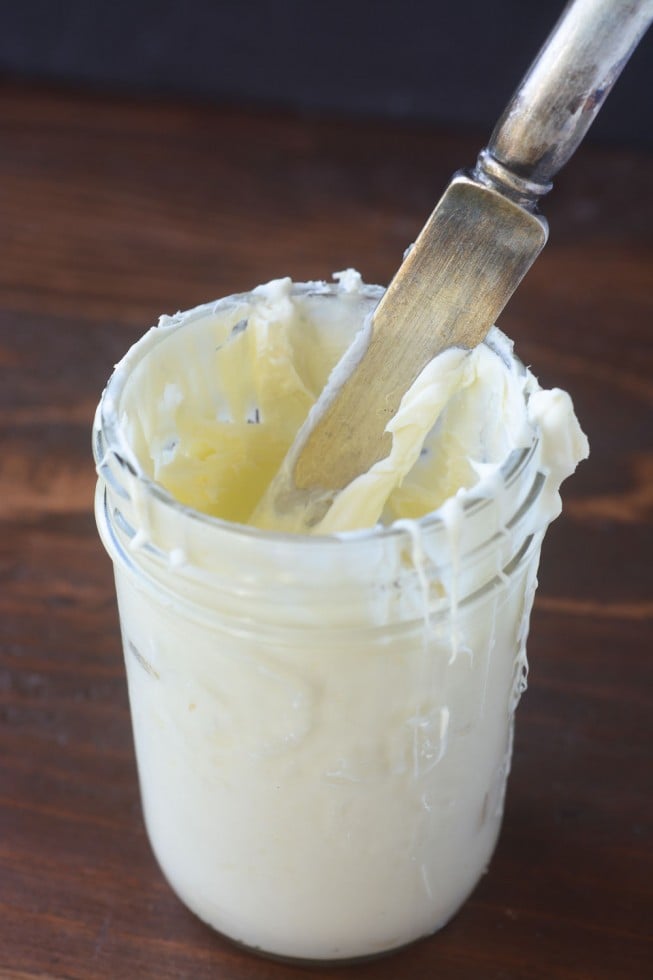
I can’t say enough good things about this project, the results far exceeded my expectations and it was absurdly easy. The only catch is that you can’t use ultra-pasteurized cream, which is cream that’s been processed for a longer shelf life. Many stores only sell ultra-pasteurized cream, so you have to search a bit for regular cream. I found mine at Whole Foods. Just read the labels… if it doesn’t say ultra-pasteurized on the label, you’re good to go.
can you make clotted cream with ultra-pasteurized cream?
Some readers in the comments below have had success with ultra-pasteurized cream. It is possible to make clotted cream from ultra-pasteurized cream, but it may be more difficult to achieve the desired texture and flavor. Ultra-pasteurization is a process that heats the cream to a higher temperature than regular pasteurization, which extends its shelf life but can also alter the proteins and enzymes in the cream. This can make it more difficult for the cream to form clots, which are necessary for making clotted cream.

What to eat with your homemade clotted cream
You will definitely want to make scones to go with your homemade clotted cream. I have lots of recipes for scones on the blog, but a simple one to start with is my Classic Cream Scones Recipe.
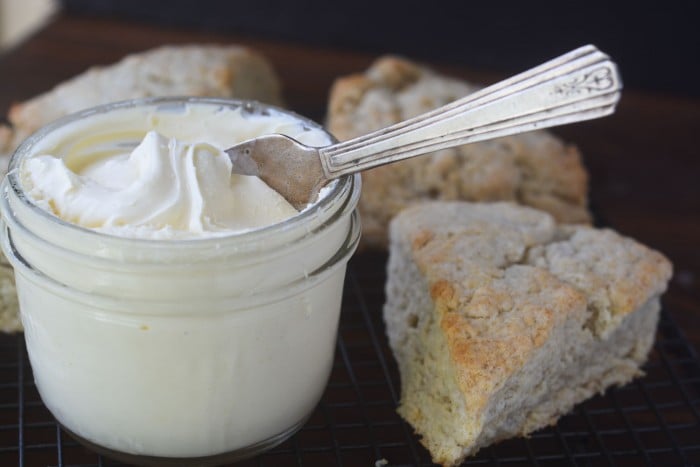
Tips for making clotted cream
- Make sure your cream is not ‘ultra pasteurized’, you will need to find regular pasteurized cream at a Whole Foods or other similar store. Ultra pasteurized cream has been treated in a way that prevents it from ‘clotting’.
- An oven thermometer is an essential kitchen tool, and really comes in handy for this project. If your oven is too cool or too hot your homemade clotted cream will not ‘clot’. Set your oven to 180F and then check the thermometer. You can adjust up or down as necessary.
- If your oven does not go down as low as 180F you can try one of my other methods for making clotted cream:

Homemade Clotted Cream
Video
Equipment
- a heavy casserole dish
Ingredients
- 2 pints heavy cream or whipping cream (double cream in the UK), avoid ultra-pasteurized cream for best results.
Instructions
- set your oven to 180F
- Pour the cream into the casserole dish. It should come up about 1-3 inches on the side.
- Set the dish, uncovered, in the oven and leave undisturbed for 12 hours. Be sure to leave the oven on the whole time. I do this overnight.
- Remove the dish from the oven and set to cool. Then cover and refrigerate. Note: the cream may seem thin at this point, but is going to thicken considerably overnight.
- The next morning scoop the thickened cream into a jar or jars, and cover and put back in the refrigerator. You can use the leftover cream for baking..
- Spread the clotted cream on freshly baked scones.
Nutrition


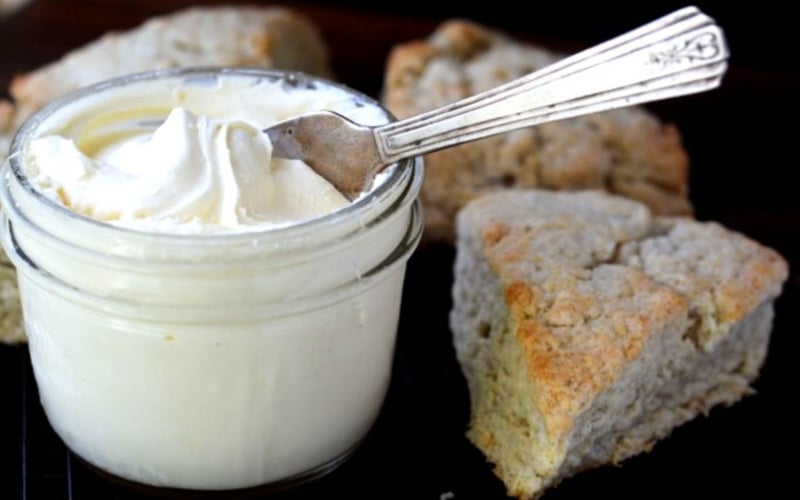




















I made it and cooled in the fridge. Do I take the browned top off somehow or just mix it in?
You can just layer it into your jar, some people like that part best. If you don’t care for it, you can scrape it off.
Mine did not turn out !! Used correct ingredient and set oven temperature at 180 for 12 hrs. There was a dark golden thin , crunchy crust on top, rest was runny. I’m thinking my oven was too hot. Don’t think I’ll try it again.
Mine turned out the same way. I was reading through the comments to see if anyone else had the same situation and why.
That was correct. It doesn’t clot (thicken) until you leave it in the fridge for 12 hours.
*Your* oven running hotter than the recipe calls for is always valid reason for giving it a one star rating ?
Hi. What is whey? You mention scooping it off. Thank you!
What I supposed to do with the remaining heavy cream after I picked up the surface like you described?!
That can be used to bake with, Elly. You can use it in cakes, muffins, scones, etc, just like you would use milk.
I’m not sure if my recipe has been ruined or not… I put the cream into a casserole and covered it with foil (I noticed in the comments some people talk about the look of the top layer so I did this preemptively). I know for sure that the cream got at least 7 hours in the oven on 180- that puts me at about 3:30am. When my husband and I woke up to make brunch my husband “turned the oven on” to 400 – this is around 1pm. I ran into the kitchen to pull out my cream and he opened the oven and pulled the cream out with his bare hands, which leads me to believe that he turned the oven off before coming to bed (sometime after 3:30- I believe I noticed the sun coming up so it could’ve been 6/6:30am). Shouldn’t the casserole dish be hot to the touch? It felt pretty cool. He doesn’t remember entering the kitchen when he got off the couch to come to bed, but if the oven was off before he “turned it on” to preheat it for brunch, then he did turn it off. So, if I assumed it was about 6 when he came to bed and assume that that he did, in fact turn off the oven, that means this cream got about 10hrs of oven time. What should I do? Just refrigerate and see what I get? Or put it back in the oven on 180- if I were to do that how much longer should I go- just the 2 hours? Should I just scrap it, get some more cream and try again? (I really hate to waste) 🙁
Gosh, that’s a pickle, LaDonna. I guess I’d say refrigerate and see what you get, and otherwise you’ll have to start over, I’m afraid.
Sooo the clotted cream came out great! I’m so upset that I’ve been deprived of this delicious phenomenon for all my 30+ years of life!! Unfortunately, my dear husband loved it too, so it disappeared within just a few hours along with all the scones lol. Thanks for the recipe – I shall share this link with the world!!
Hooray! Glad you loved it LaDonna 🙂
My life is delightfully better now, as this treat just isn’t found in the Midwest of the US!!! Came out perfect and the only thing that could have made it better would be some cream from Irish cows! But at least Midwest cows came a good approximation!
clotted cream. i noticed you were skimming top off (in picture) before refrigerating – is this the whey? you talked about using leftover for oatmeal…it would have been helpful is you had specified what exactly you were skimming and calling leftover.
thanks
I made my cream in my instant pot. I have the older model with no yogurt. I put mine on slow cook low. It seems to have turned out! But man it’s sooooo thick! Can I add the whey in to loosen it up a little? And when making scones do we just replace the half and half with the whey? I even bought strawberries to make my scones.
This is great to know, and yes, you can stir in a little whey to loosen it. You can mix half and half with whey for scones if you like, it will make it a little richer.
My cream developed a thick yellow skin. What do you do with that? Looks awful mixed in. Thx.
The yellow layer is one of the best parts, I usually just pack it into a jar along with the rest of the thick cream without stirring it in.
Thx Sue. If I decide to make another batch and cover, think a corning ware casserole dish will work well?
Yes, that would work well.
Hello Sue,
Trying this out today. It is perfect rainy day for it. Can you flovor the clogged cream with vanilla or spices such as cinnamon or cardamom?
Thank you for posting this.
I’ve never done that, but you could flavor it Elle, just mix it into the finished cream.
I haven’t tried the recipe yet. I just wanted to let everyone know, if you are in the Northeast, Stewart’s shops have the cream you are looking for!
Thanks Kristina!